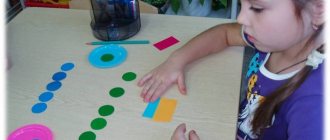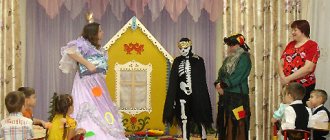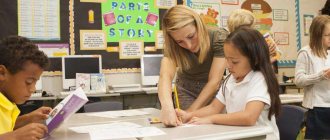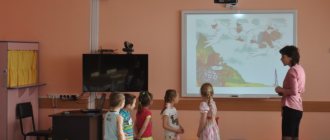Abstract of OD on FEMP in the senior group “Journey to the Kingdom of Mathematics”
Summary of the final lesson on FEMP “Journey to the Kingdom of Mathematics”
for older children
Training tasks:
1. Consolidate knowledge about the composition of numbers within 10 of the two smaller numbers. 2. Consolidate knowledge about the sequence of days of the week and seasons. 3. Strengthen the ability to compare 2 adjacent numbers using the greater than, less than, and equal signs. 4. Strengthen the ability to distinguish between concepts: higher – lower, compare objects by height. 5. Strengthen children’s ideas about geometric shapes: the ability to distinguish geometric shapes, the ability to compare them by properties (color, shape and size).
Developmental tasks:
1. Develop logical thinking, intelligence, attention. 2. Promote the development of speech, the ability to give reasons for one’s statements.
Educational tasks:
1. Foster independence, the ability to understand a learning task and complete it independently. 2. Cultivate interest in mathematics.
Methodical techniques:
Calming exercises before class. Gaming (use of surprise moments). Visual (use of illustration). Verbal (reminder, instructions, questions, individual answers from children). Encouragement, lesson analysis. Equipment: magnetic board, numbers, signs.
Demo material:
"letter", castle with geometric shapes, door illustration, board game.
Handouts:
a set of numbers for each child, cards with tasks for comparing numbers, a geometric figure - a circle, pencils, cards with number houses.
Material:
"Math Kingdom" poster, castle with geometric shapes; houses for comparison in height, 3 sets of 4 pcs., number houses for checking, sheet A 3, glue for applique, chest with sweets.
Progress of direct educational activities:
Educator:
Guys, I'm very glad to see you. Please stand in a circle. All the children gathered in a circle, I am your friend and you are my friend. Let's hold hands tightly and smile at each other. Guys, I'm very glad to see you. Hold hands and give each other a smile. Now look at our guests, give them a smile. Great!
Educator:
Now show me your fingers. Let's make them friends (coordination of movements and development of fine motor skills, memory development). The girls and boys in our group are friends. You and I will make friends with little fingers. 1, 2, 3, 4, 5! Let's start counting again: 5, 4, 3, 2, 1 - We stand together in a circle! Well done! (Calm music sounds). Sit down on the carpet.
Educator:
Guys, this morning on the table I found a letter addressed to the children of the senior group.
Do you want to know who it is from? (Yes, we need to read the letter and we will find out who it is from).
Text of the letter: “Dear guys, trouble has happened in our mathematical kingdom. An evil wizard bewitched all the inhabitants of the kingdom - all the numbers got mixed up in the number series, and the geometric figures forgot their names. I have been watching for a whole year how interesting you played in math classes, only you can remove the spell by completing all the tasks. Queen of Mathematics"
.
—What does the Queen of Mathematics ask you to do? (Help numbers and geometric shapes.)
— Do you like to help? (Yes, we love)
-Who are you helping? ( Mom, dad, grandma,
I help my sister.)
- Do you want to help the Queen of Mathematics? (Yes, x otim.)
- How can I help her? ( We must go to the kingdom of mathematics.)
-Can we help? (Yes.)
- Why do you think so? ( We know geometric shapes, we can count, we are friendly.)
Educator:
-Guys, will we help the inhabitants of the mathematical kingdom?
Then we go on a journey to a mathematical land. And we will get there through a magic door. We all close our eyes ( pass through the ribbons
).
- Oh, guys, an evil wizard hung a huge castle on the gates of the kingdom. To open it, we need to unravel one secret - guess which of the figures is extra. -Guys, what geometric shapes do you see on the castle?
-Are there any identical figures here?
-Compare them and tell me how they are similar, what do they have in common? (Comparison by shape, color, size).
-How are the figures different?
-Which figure do you think is the odd one out? ( a circle has no corners).
-Well done, the castle is open, we can go into the mathematical kingdom. -And our first task awaits us. Let's sit down at the tables.
1 task
Educator:
An evil wizard bewitched all the numbers, they forgot their places and got mixed up.
Help each number fall into place. Place them in order from smallest to largest ( each child individually lays out a number line using wooden numbers from 1 to 10
). Elvina, count the numbers in order, the way you arranged them. Yana, try to count differently - count down from 10 to 1.
Educator:
Guys, let's check what number you put between numbers 3 and 5.
-What number did you place between the numbers 7 and 9? -Name the neighbors of the numbers 6, 2, 9.
-Name a number that is greater than the number 3 by 1. -Name a number that is greater than the number 5 by 1.
-Name a number that is less than 8 by 1.
-Name a number that is less than 10 by 1.
-Well done, you did a great job with the 1st task. Now each number has taken its right place in the number series.
2 task
Educator:
Now, guys, let's take a little rest. Get up from the tables and come out to me. A physical moment awaits us!!! Quickly stand up, smile, Stretch higher, higher, come on, straighten your shoulders, lift, lower, turn left, right, touch the floor with your hands, sit down, stand up, sit down, stand up, and jump in place.
Task 3
Educator:
The Queen of Mathematics loves order in everything.
So the houses on the streets in the mathematical kingdom were arranged in order from highest to lowest. On one street there were multi-colored houses with a pink roof, on another with a quadrangular blue roof, and on the third street the houses were brown without a roof. The wizard caused confusion here too. You need to arrange the houses in height from high to low, not forgetting that on the same street there are houses with the same roof. Educator:
-Ignat, tell us about your house (it’s the largest, 4-story);
-Arseny, tell us about your house (the smallest one-story)
;
-Sasha, tell me about your house (my house has two floors, it is lower than a 3-story house, but higher than a 2-story house).
Educator: Now arrange the houses differently - let all the 4-story houses stand in a row, making a street of 4-story houses, 3-story houses on another, 2-story houses on the next street, one-story houses on the last street. Well done, you completed the task.
Task 4
Teacher:
Guys, let's play. This game - the "True or False" test will help correct the mistakes that the evil sorcerer deliberately left here and there. If you hear what you think is correct, clap your hands, but if you hear something that is not correct, shake your head: - in the morning the sun rises; - you need to do exercises in the morning; - you can’t wash your face in the morning; — the moon shines brightly during the day; — in the morning the children go to kindergarten; - people have dinner at night; - in the evening the whole family gathers at home; - there are 7 days in a week; — Monday is followed by Wednesday; - after Saturday comes Sunday; - Thursday is before Friday; - only 5 seasons; — spring comes after summer.
Task 5
Educator:
An evil wizard bewitched the inhabitants of the mathematical kingdom using a magic circle.
If we guys divide the magic circle into equal parts, the sorcerer will no longer be able to do mischief, and will turn into a good wizard. You have multi-colored circles on the tables - fold your circle into 2 equal parts. How should you fold so that the parts are the same? ( Align edges)
What can you call each of the parts?
( ½
).
Now fold it in half again? What is the resulting part of the circle called now? (¼
). Well done, the evil spell has been broken!!!
Educator:
Now it's time to return to the group.
How do we get back? (Through the magic door).
-So you and I visited the Kingdom of Mathematics. Let's make one big beautiful carpet for our already good wizard, laying out a pattern of multi-colored circles. With this carpet, the wizard will perform only good miracles. (Performing a collective application.)
Guys, you have completed all the tasks, brought order to the mathematical kingdom, and turned the evil sorcerer into a good wizard. The Queen is very grateful to you for your help.
- Guys, did you like our trip? (Yes, I liked it!)
-What did we do? (They brought order to the mathematical kingdom, and turned the evil sorcerer into a good wizard)
.
-What was especially easy for you? (Work with numbers; compare geometric shapes)
-Why did you succeed? (We all know you are friendly and attentive)
-What seemed difficult? (Clean up order on the streets of the Mathematical Kingdom)
And the Queen of Mathematics left this chest in gratitude for your help. Shall we look into it? Look, these are sweet gifts!!!
MAGAZINE Preschooler.RF
Abstract of GCD on the formation of elementary mathematical concepts in the senior speech group.Educator: Filippova A. S.
Lexical topic: “Adults and children know: there are a lot of fruits in the world .
Goal: creating conditions for fixing geometric shapes (triangle, circle, oval, square).
Tasks:
- educational: teach to recognize geometric shapes in surrounding objects (triangle, circle, oval, square), consolidate children’s ideas about geometric shapes, teach. Improve quantitative and ordinal counting skills and orientation on a plane
- correctional and developmental: develop thought processes, speech activity and orientation skills on a plane
- educational: develop skills of cooperation and interaction
- developmental: to develop in children the ability to switch from one type of activity to another and the ability to think logically.
Equipment: knitted fruit samples, magnetic board, flat images of fruits on magnets (banana, lemon, kiwi, orange, apple, pear, bunch of grapes), images of geometric shapes, A3 sheets with images of fruits in the center of the sheet, oil crayons.
Preliminary work: visiting a store with parents, looking at and buying fruit; modeling the situation in kindergarten for orientation in space; enrichment of the passive vocabulary with adverbs on the left, right, below, above, in the middle, next to; learning exercises to develop general motor skills.
Progress of the lesson
Motivation. The teacher brings a knitted pear, apple and lemon into the group.
- Guys, look what the guys from the other group gave me. What is it, have you guessed it?
(children guess)
- Do you know what geometric shapes these fruits look like?
(children answer)
— I have other fruits, do you want to know what shape they are?
(children answer)
The teacher shows the children a box containing illustrations of fruits on magnets and invites everyone to take one picture from the bag - a fruit.
Geometric shapes (circle, oval, triangle, square) are already fixed on the magnetic board.
- Attach your fruit to the shape that your fruit resembles.
(children complete the task)
After that, everyone checks together and discusses whether everyone has attached the pictures - fruits - correctly.
- Let's count how many fruits there were, how many fruits there are near each figure.
(children count and pay attention to the fact that there are no fruits near the square).
— Do you think there are square-shaped fruits at all?
(children answer)
- Tell me, guys, do you see square-shaped objects in our group? We will just call them this way. For example, on the shelf to my right is a green cube shape. And so on.
(the guys answer, the teacher helps to construct sentences correctly)
Physical exercise.
- How blush is the autumn garden! Light clapping of palms on the cheeks.
- There are apples hanging everywhere. Raise your hands up.
- Red-sided, red-cheeked. Hands on the belt, turns right - left.
- Raise your hands up on your tall branches.
- Like the suns are burning Join your hands in a circle above your head.
— Guys, I have prepared another task for you. In front of you are sheets of paper and crayons. Crayons can be taken in any color. Now I will tell you the task, and you listen carefully and complete it.
- Draw a triangle on the left side of the piece of paper.
- Draw an oval on the sheet of paper on the right.
- Draw a square at the top of a piece of paper.
- Draw a circle on a piece of paper below.
- Draw the fruit you like best in the middle of the sheet and connect it with a line to the shape it resembles.
- Color any geometric shape you want.
(children complete tasks)
- Let's remember what geometric shapes we repeated today.
(children answer)
- Guys, let's tell your parents what we did today. And for this, I have prepared hatching patterns for you, which you will do at home with your parents when you tell them about geometric shapes, but I hid them in the group. Want to find them?
(children answer)
“Then you need to follow my verbal instructions.” Face the center of nature, then turn left and go straight to the palace. To your right, on the top of the sports shelf, there is a file with tasks.
(children follow instructions)
- How well you handled everything! Congratulations! If you have a desire, you can now practice shading.
| Next > |
Summary of GCD for FEMP in the senior group according to the Federal State Educational Standard “Journey through a Fairy Tale”
MKDOU "Kalacheevsky kindergarten No. 1 of general developmental type"
Summary of GCD for FEMP in the senior group according to the Federal State Educational Standard “Journey through a Fairy Tale”
Prepared by: Belikova Vera Aleksandrovna, teacher
Topic: Ordinal counting up to 10 Goal: to create conditions for consolidating ordinal counting up to 10. Objectives: Educational: to promote the accumulation of skills in counting to 10 and back, the ability to correlate the number of objects with a number; knowledge of geometric shapes (circle, oval, square, rectangle, triangle), names of days of the week, seasons, months and their sequence. Strengthen the ability to navigate on a sheet of paper. Developmental: develop social skills, the ability to work in a group, in pairs; find a solution and draw conclusions. Develop attention, logical thinking, memory and speech. Educational: to cultivate restraint, perseverance, goodwill, feelings of mutual assistance, and the desire to help. Types of children's activities: gaming, productive, musical and artistic. Forms of organization: frontal, individual, group, work in pairs. Form of implementation: use of manuals, musical accompaniment, demonstration of illustrative aids, ICT; searching and problematic questions for children, encouragement, explanation, leading to a conclusion; creation of play motivation, active activity of children, comparison, juxtaposition, surprise moment. Equipment: fairy-tale music, geometric shapes, cards with numbers, magnetic board, bell, “stones”. Demonstration material: Drawing of a castle, entrance littered with stones, Handouts: Cards with numbers, Cuisenaire counting sticks, lined sheets, envelope with geometric shapes, colored pencils, coloring books. OF NOD Stages Activities of the teacher Activities of children Notes 1. Organizational moment. - The bell rang and invited us to gather in a circle! - Guys, do you like to listen to fairy tales? – Would you like to get into a fairy tale and help our heroes? -Today I want to tell you a fairy tale, it’s not a simple fairy tale, it’s magical, with mathematical tasks. -And to get into a fairy tale, you need to close your eyes and say the magic words “1, 2, 3 turn around, find yourself in a fairy tale.” Open your eyes. The fairy tale begins. Children enter the group to the music. -Yes -Yes 2. Main part. - Once upon a time there lived a king. And he had a beautiful daughter. Once the king left on his royal business, but his daughter remained at home. She went out into the garden for a walk, and then the wind came, picked up the princess and carried her off to a distant kingdom. Ivan Tsarevich became sad and went to look for the princess. A day goes by, two days go by. Approaches the hut on chicken legs. And Baba Yaga lives there. Ivan Tsarevich told about his misfortune. Baba Yaga promised to help if Ivan Tsarevich answered her questions. – What day of the week is it today? – What day of the week was yesterday? – What day of the week will it be tomorrow? – What day of the week will be the day after tomorrow? – What seasons do you know? Name it. - How many months are there in a year? Name it. – Name the parts of the day.
– Wednesday
– Tuesday – Thursday – Friday -Winter, spring, summer, autumn -12 Morning, afternoon, evening, night
Graphic dictation - We completed Baba Yaga’s task. - Well done! – Baba Yaga gave a ball and sent the Tsarevich to Kikimora. She has a map. The ball rolled, and the Tsarevich followed it. The ball rolled towards the swamp. And Kikimora appeared in front of the Tsarevich. She listened to the Tsarevich and decided to help, and in order to get the card, she had to complete her task. - Let's help Ivan Tsarevich. -You have pencils and paper in front of you. – Get ready to listen to the task and draw – draw a red triangle in the upper left corner; – draw a green square in the lower right corner; – draw a black oval in the center; – draw a blue rectangle in the lower left corner; -draw a yellow circle in the upper right corner.
Children perform dictation
– What geometric figure did Vanya draw in the lower right corner? – Where did Sofia draw the yellow circle? – In what corner did Andrey draw the oval?
What shapes did we not draw? -Green square - In the upper right corner - None - Oval in the center - Rhombus, trapezoid - We completed the task, and Kikimora gave the map to Ivan Tsarevich, you can go further. The ball rolled further and brought Ivan Tsarevich into the fairy-tale forest. - So we found ourselves in a fairy forest. Miracles happen in the forest. The forest dwellers have prepared a task. – How many ears do two mice have? Why?
– How many bellies do 5 hippos have? – Birds were flying over the river: a pigeon, a pike, two tits? How many birds? Why?
– How many hooves does a horse have when the horse lies in the grass? – How many houses do 100 ants have? How many times a year does Ivan Tsarevich have a birthday? And you? The forest inhabitants advised him to gain strength to move on.
– 4 One mouse has two ears 2+2 equals 4 – Five
-3 Pike is not a bird - Four - One - One -One Physical education lesson - Ivan Tsarevich once - bent over, straightened up, Two - bent over, straightened up, spread his arms to the sides, and walked, walked, followed the Princess into the wilderness of the forest, suddenly he saw a stump He sat down quietly and dozed off. Children, together with the teacher, perform physical exercises - Children, open your eyes, you see, there is a castle in front of us. - Here is the entrance to the castle. – The door behind which the Princess is hidden is littered with stones. -To enter the castle you need to dismantle the stones. Roma will sort it out at the board, and we will help him at the tables. In front of you is a number series from 1 to 10. - Everyone got ready and started working. – Name a number greater than 2 by 1 – Name a small number
– The largest • – A number that is less than 7 by 1
– Name the neighbors of the number 6 • – Show a number greater than 3 by 1
– Name the neighbors of the number 9
Children go to the tables
– three – one – 10
– six – 5 and 7
– 4 – 8 and 9 – Well done, we cleared the door to the castle of stones. - But we can’t enter, we need to complete one more task, if everything is done correctly, the door will open. – Ivan Tsarevich dropped the crystal key on the ground, and it may have broken and been lost. Guys, in order for us to find the key, we need to collect it.
Children make a key out of sticks
from Cuisenaire sticks - Well done. -And now you and I will insert the key into the lock and free the princess. The fairy tale heroes come out, thank the children for their help and “give” the children coloring books. The children insert the key into the lock and open the gate. The fairy tale heroes say goodbye to the children.
The final part - And now it’s time for us to return to kindergarten. Close your eyes and start counting from 1 to 5.
– Where did we travel today, guys?
- What did you like?
– What would you like to wish our guests?
Children count in chorus - Here we are in kindergarten. We visited a fairy tale, We learned a lot, We returned back, The kindergarten is very happy to see us. – In a fairy tale - perform various tasks Children say wishes to guests
Used Books: . Comprehensive thematic planning according to the program edited by N.E. Veraksy, T.S. Komarova, M.A. Vasilyeva. Senior group. Teacher, 2015. Complex classes according to the program “From birth to school” edited by N.E. Veraksy, T.S. Komarova, M.A. Vasilyeva. Senior group/author - comp. N.V. Lobodina. Volgograd: Teacher, 2015. Falkovich T.A., Barylkina L.P. Formation of mathematical concepts: Classes for preschoolers in additional education institutions. – M.: VAKO, 2009. Novikova V.P. Mathematics in kindergarten. – M.: MOSAIC – SYNTHESIS, 2009.






